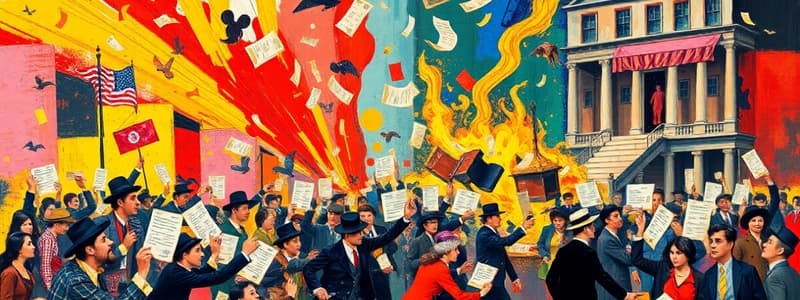Podcast
Questions and Answers
What is the primary focus of the provided information regarding Grover Cleveland's presidency?
What is the primary focus of the provided information regarding Grover Cleveland's presidency?
- His foreign policy decisions during his second term.
- His experiences in the Civil War.
- His early life and family history.
- The economic downturn known as the Panic of 1893. (correct)
Which period is covered by Grover Cleveland's two non-consecutive presidencies?
Which period is covered by Grover Cleveland's two non-consecutive presidencies?
- 1885 to 1889 and 1892 to 1896
- 1881 to 1885 and 1889 to 1893
- 1881 to 1889 and 1893 to 1901
- 1885 to 1889 and 1893 to 1897 (correct)
What specific economic event is highlighted as a major issue during Grover Cleveland's presidencies?
What specific economic event is highlighted as a major issue during Grover Cleveland's presidencies?
- The Great Depression of 1929
- The Panic of 1893 (correct)
- The Recession of 1884
- The Gold Rush of 1898
Besides the Panic of 1893, what other areas are identified as topics related to Grover Cleveland's presidency?
Besides the Panic of 1893, what other areas are identified as topics related to Grover Cleveland's presidency?
What tone is indicated by the words "Panic", "Issues", and "Major Events regarding the information about Grover Cleveland?
What tone is indicated by the words "Panic", "Issues", and "Major Events regarding the information about Grover Cleveland?
During which era did the Panic of 1893 occur?
During which era did the Panic of 1893 occur?
What was the approximate national unemployment rate during the peak of the Panic of 1893?
What was the approximate national unemployment rate during the peak of the Panic of 1893?
Which U.S. President served during the Panic of 1893?
Which U.S. President served during the Panic of 1893?
What was a primary cause of the bank collapses during the Panic of 1893?
What was a primary cause of the bank collapses during the Panic of 1893?
Which of the following was NOT a common result of the Panic of 1893?
Which of the following was NOT a common result of the Panic of 1893?
Flashcards
Panic of 1893
Panic of 1893
A severe economic recession in the United States that began in 1893, characterized by widespread bank failures, business closures, and unemployment.
Grover Cleveland's Presidency
Grover Cleveland's Presidency
Grover Cleveland served as the 22nd and 24th President of the United States, holding two non-consecutive terms.
Cleveland's Presidency and Panic of 1893
Cleveland's Presidency and Panic of 1893
The period during Grover Cleveland's presidency was marked by the Panic of 1893, a major economic crisis that significantly impacted the nation.
Challenges Faced by Grover Cleveland
Challenges Faced by Grover Cleveland
Signup and view all the flashcards
Impact of the Panic of 1893
Impact of the Panic of 1893
Signup and view all the flashcards
Over Speculation
Over Speculation
Signup and view all the flashcards
Bank Runs
Bank Runs
Signup and view all the flashcards
Deflation
Deflation
Signup and view all the flashcards
Pullman Strike
Pullman Strike
Signup and view all the flashcards
Gilded Age
Gilded Age
Signup and view all the flashcards
Unemployment
Unemployment
Signup and view all the flashcards
Grover Cleveland
Grover Cleveland
Signup and view all the flashcards
What was the Panic of 1893?
What was the Panic of 1893?
Signup and view all the flashcards
What is overspeculation?
What is overspeculation?
Signup and view all the flashcards
What are bank runs?
What are bank runs?
Signup and view all the flashcards
What is deflation?
What is deflation?
Signup and view all the flashcards
What was the Pullman Strike?
What was the Pullman Strike?
Signup and view all the flashcards
Study Notes
Panic of 1893: Summary and Facts
- The Panic of 1893 was a severe financial crisis in the United States, triggering a four-year depression during the Gilded Age.
- It led to high unemployment, approaching 20%, significant economic hardship, and social unrest, including labor actions like the Pullman Strike.
- Over-speculation in railroads, especially the Philadelphia & Reading Railroad, significantly contributed to the crisis.
- Major banks collapsed due to these failures, leading to runs on state banks and widespread foreclosures and bankruptcies.
- Prices for manufactured goods fell, inflation rose, and credit became scarce.
- The crisis resulted in mass unemployment across various sectors (railroads, factories, and farms).
- Many people lost their homes and livelihoods, relying on charity for survival.
- Labor disputes escalated into violent clashes between workers and authorities, exemplified by the Pullman Strike and national strikes by the United Mine Workers of America.
- Grover Cleveland was president during this crisis, serving two non-consecutive terms, from March 4, 1885 to March 4, 1889 and March 4, 1893 to March 4, 1897.
Studying That Suits You
Use AI to generate personalized quizzes and flashcards to suit your learning preferences.




